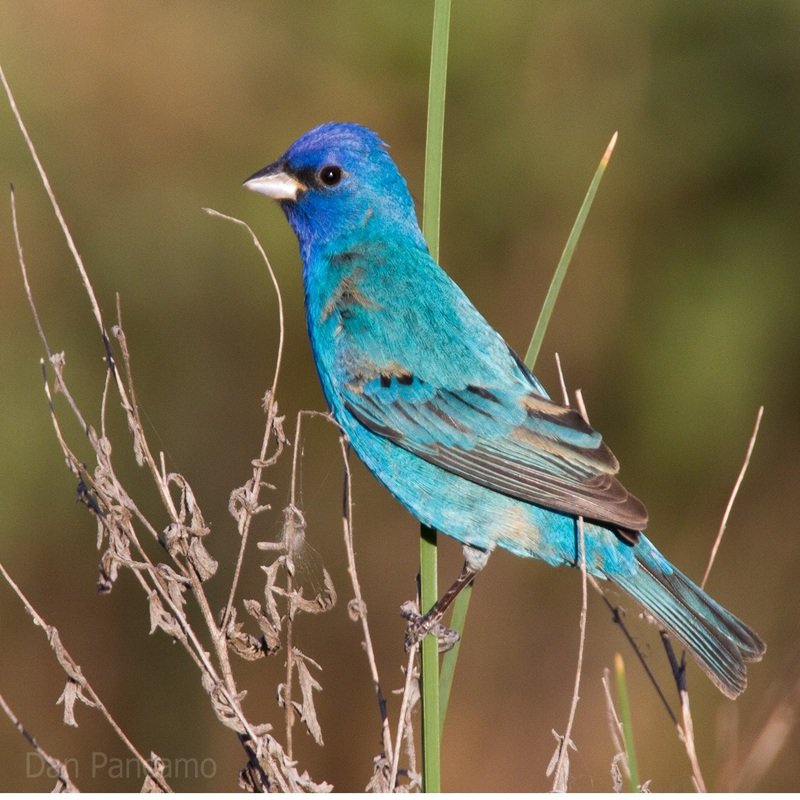The indigo bunting (Passerina cyanea) is a small seed-eating bird that is a member of the Cardinalidae family of passerine birds that can be found in North and Central America. The current genus name, Passerina, is derived from the Latin term passer, which refers to true sparrows and other similarly small birds, whereas the species name, cyanea, is derived from the Latin word cyan, which refers to the color of the male’s breeding plumage in the spring.
Quick Overview: Passerina Cyanea – Indigo Bunting
Body size: Around 5.25-5.75 in (13-15 cm) in length and weighed 14 g (0.5 oz).
Main colors: Blue, Purple, Brown
Range: Central and North America
Migratory Bird: Yes
Best time of the year to see in the U.S.: January, February, June, July, August, September, December
Conservation Status: Least Concern
Indigo bunting Description
The blue plumage of this small finch is brilliant, almost iridescent in its brilliance. The color of the crown is a darker blue with a purple tint. Brown in color, with blurred wing bars, unstreaked backs, streaked breasts and bellies, and blue tinges on the shoulders and tails of the female species. Winter and early spring males are similar in appearance to females, but they are flecked with blue feathers.

Size
This medium-sized bird is 5.25-5.75 in (13-15 cm) in length and weighed 14 g (0.5 oz). Its wingspan could range around 8-9 in(20-23 cm).
Feeding
It forages in trees, shrubs, and on the ground for seeds, forbs, buds, insects, and berries; it is a seed-eating bird.
Habitat
Indigo buntings can be found in a variety of habitats including brushy forest edges, open deciduous woods, second-growth woodland, and farmland. As a result of forest clearing and the conversion of land into farms, there has been an increase in the size of the population.
Behavior
Indigo buntings are usually found in groups of two or three. Men establish and defend a territory ranging in size from 0.4 to 8 hectares (acres) during the breeding season. Each territory may have one or more females, depending on the size of the territory. While indigo buntings roost in large flocks at night, they spend their days foraging on their own or in small groups. There does not appear to be a hierarchy of dominance within these groups.
Passerina cyanea Scientific Classification
- Kingdom: Animalia
- Phylum: Arthropoda
- Subphylum: Chelicerata
- Class: Aves
- Order: Passeriformes
- Family: Cardinalidae
- Genus: Passerina
- Species: Passerina cyanae
Best time of the year to see
The best time to see these birds in the United States are during summer (June to September) and winter (December to February).
Distribution of the Indigo bunting bird in the USA
The Indigo bunting is native to numerous countries throughout the Caribbean as well as Central America and North America. It is also a visitor to countries in Europe as well.
The Indigo bunting bird can be found in the following states in the United States – Alabama, Arkansas, Colorado, Connecticut, Delaware, Florida, Georgia, Hawaii, Illinois, Indiana, Iowa, Kansas, Kentucky, Louisiana, Maine, Maryland, Massachusetts, Michigan, Minnesota, Mississippi, Missouri, Nebraska, New Hampshire, New Jersey, New Mexico, New York, North Carolina, North Dakota, Ohio, Oklahoma, Pennsylvania, Rhode Island, South Carolina, South Dakota, Tennessee, Texas, Vermont, Virginia, West Virginia, and Wisconsin.
